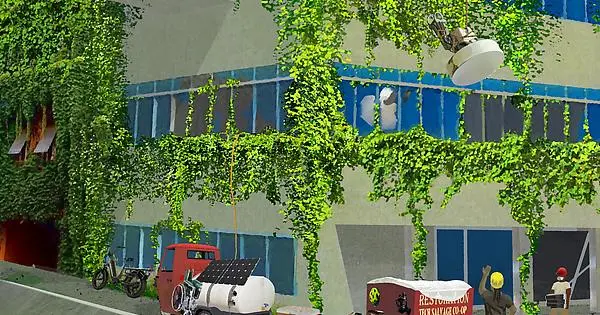I’ve been thinking lately that I’d like to see more art that was meant from the start to be solarpunk. So I put together this photobash. If it goes over okay, I think I’ll try some other scenes along similar lines, trying to depict what I think of as aspirational aspects of a fictional solarpunk society.
This one shows part of a tech salvage co-op on a tech raid (inspired by arcade cabinet raids) where members of a co-op have located unused, in-tact technology, and have negotiated with the current occupants (or owners if no one lives there) for the recovery of the devices. These will then be used to extend the meshnet or add redundancies, improve the capabilities of libraries, or provide to others in their community.
I picture this being a kind of exciting event for those involved – all the members of the co-op, along with friends and relatives who wanted to help, would participate. People would pack for spending all day or days exploring and working in an abandoned building, and a motley collection of vehicles, mostly electrical and pedal-powered, would navigate some fairly rough and overgrown roads to the site. The co-op would hopefully have a fairly well planned system, with different roles (based on training and capabilities) and necessary equipment, defined ahead of time.
At the site, they’d meet with any occupants or owners, announce themselves, and start confirming whatever earlier scouting parties might have found. From there it would be something of a combination of urbexing, unlicensed electrical work to make things safe, and a lot of physical labor hauling everything out and packing it for the ride home. There’d likely be a fairly steady stream of vehicles rolling from the site back to whatever settlement the co-op operates out of.
I imagine a lot of the people supporting a raid are volunteers, either along for fun or on a favor-for-favor basis. I imagine that the local cycling clubs, rock climbing clubs, volunteer medics, bakeries, and bike-repair co-ops who support the thing all have excellent technology back home.
As for likely raid sites, I see office parks as being kind of unnecessary in general, and especially so in this setting (one I’ve been playing with for a bit but haven’t published anything in yet), where society and infrastructure crumbling have made commuting unreasonable and some of the work unnecessary. Being outside the cities and not in immediate use, they would have been a low priority for restoration/re-occupancy, making them a good candidate for this kind of salvage operation decades on.



Hmm, that building looks like something that might rather still serve a community function. Maybe more realistic would be abandoned suburbs or industrial sites like refineries?
I’ll probably do more so I’m happy to take suggestions, for both locations and scenes in general.
I picked an office building because around here, they tend to be located in suburbs or their own remote locations zoned just for that, which would likely be impractical for where people have resettled/rebuilt. Maybe useful to local farmers as storage, but too far out to justify doing office work in a world where the internet still mostly enables connectivity and the suburbs have faded and the grid might not support running power to these sites. They’re also likely to have more abandoned technology, and not much worth stealing when things were a little more postapocalyptic, so the tech might be more intact. Plus I’d like there to be more punk in solarpunk; ruined and abandoned office buildings fit that a bit, I think, like leaving behind that whole cultural structure.
Looking back on it, I could definitely have made it look more decrepit, beyond the broken windows. I could have shifted the frame, sagged the overall shape so it was clear the foundation and structure were bad. I might rework this one or just do others in the future. I’d also made the site look more crowded than most office complexes with their endless parking lots and lawns, which probably makes it look more city-like. That makes sense, I wanted the shot to look interesting, and I find cities way more visually compelling than suburban sprawl and office parks (though that wasn’t a very practical decision given my goals). Let’s compromise and say it’s some tech campus, just remote and cheaply-built enough to be impractical for a rebuilding society, but kind of crowded compared to most office parks.
Let me know if you have any scenes you’d like to see. I can use the photobash and scene-composition practice, and I’d like there to be more solarpunk art that sets out to showcase possibilities/options rather than just a nice cityscape. Optimistic moments in a less-optimistic setting, people helping each other in or after climate disasters and societal crumbles, or rebuilding a more deliberate, colorful, and inclusive world. I’ll probably prioritize rewilding and reuse. I want the conception of solarpunk to include salvaging what’s there, using the resources we have in the moment, regardless of their provenience, while reconsidering how/if we make things new.
The density of this office block makes it basicly a mid rise development without any housing. However converting it seems possible to me.
I partially agree, but ransacking broken technology does not need to make the building unsuitable for other community functions, quite the contrary, it could even help. For example, a decayed server room can be dangerous due to heavy metals or other components and would serve no real purpose to a community-oriented building (as well as so many satellite dishes). So the raiding could both make use of the materials and make the building safe for other uses.